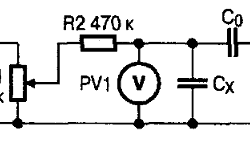Interesting research on ceramic capacitors

I found an interesting article about the capacitance of ceramic capacitors may depend on voltage applied. In some designs, you can face a problem when ceramic capacitor capacitance may strongly depend on voltage. Few tests were done with various capacitors using the following circuit: In the circuit CX – tested capacitor; C0 – known capacitor. Voltage vas regulated from 0 to 50V using potentiometer R1. 50V is taken as the nominal voltage of the ceramic capacitor. Because Two capacitors are connected in series the total capacitance is C=CX·C0/(CX+C0) then we find the capacitance of tested capacitor CX=C·C0/(C0-C); C0 is about 10 % of CX value. There were several capacitors tested and stunning results were found. – Some of the capacitors lost capacitance from 10 to 15 times due to the increase of voltage up to 50V. Even when 10% of voltage were applied the capacitance was only about 35 – 40% of nominal value. The only explanation may be that low-quality dielectric material is used in (no-name) ceramic capacitors. Of course, not all capacitors gave the following results. But be ready for this when using unknown producer ceramic capacitors.










